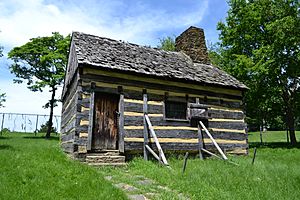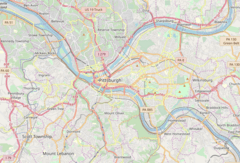Neill Log House facts for kids

Neill (Neal) Log House in June 2019
|
|
| Location | East Circuit Road near Serpentine Drive in Schenley Park, Pittsburgh, Pennsylvania |
|---|---|
| Coordinates | 40°26′09″N 79°56′08″W / 40.435847°N 79.935606°W |
| Built/founded | ca. 1765 |
| Governing body/ |
City of Pittsburgh |
| CPHD designated | February 28, 1977 |
| PHLF designated | 1970 |
The Neill (Neal) Log House is a very old log cabin located in Pittsburgh, Pennsylvania. It was built around 1765, making it the oldest home in the city! Other old buildings in Pittsburgh include The Old Stone Inn (from 1756, though not fully confirmed) and The Fort Pitt Block House (from 1764).
The Pittsburgh History and Landmarks Foundation recognized the Neill Log House by placing a special Historic Landmark Plaque on it in 1970. Later, in 1977, it was officially named a City of Pittsburgh Designated Historic Structure. Today, it is a part of the Schenley Park U.S. Historic District.
Contents
The Neill Family's Story
The Neill (or Neal) family built this log house around 1765. They owned a large area of land, about 262 acres, which is now part of Schenley Park. The family's journey to Pittsburgh began with John Neal, who came from Ireland around 1736. He settled in what is now Harrisburg, Pennsylvania.
His son, William, and William's wife, Margaret, were also born in Ireland. They moved to the Harrisburg homestead. William and Margaret had seven more children: John, Robert, James, Margaret, Jean, Eleanor, and Agnes (Nancy).
Building the Cabin
Robert Neal, one of William's sons, bought the land in Pittsburgh. He then built this log cabin. Robert also created a trade route using wagons pulled by horses, called a Conestoga trade route. This route went from Pittsburgh all the way to Philadelphia, using his father's homestead in Harrisburg as a stopping point.
Who Owned the House Next?
Over the years, the Neill Log House was owned by several different people. Eventually, it was sold to a man named Colonel James O'Hara. Colonel O'Hara later left the property to his granddaughter, Mary Schenley.
In 1889, Mary Schenley generously donated the land, including the log house, to the city of Pittsburgh. This land became what we know today as Schenley Park.
The House Today
The Neill Log House is still preserved in Schenley Park. There is a fence around it to protect it, but visitors can sometimes go inside during special events. It's a great way to see what homes were like long ago!
The log house is even famous enough to be on the cover of a book! It's featured on A Guidebook To Historic Western Pennsylvania by Helene Smith and George Swetnam.
Life on the Frontier
In the past, the Neill Log House was a strong, fortified home for a frontiersman. It was built with thick, heavy logs. The spaces between the logs were filled with flat stones and clay. This was to protect the family from attacks, especially from Native Americans.
The house had special "loophole windows." These were very narrow openings, about two feet long and less than a foot high. They were designed for shooting through, not for looking out. This shows how important safety was back then.
A Busy Location
The Neill Log House was located very close to Nemacolin’s Trail. This trail later became known as the "Old Road." It was an important path that connected Philadelphia to Fort Pitt (which is now Pittsburgh). Wagons full of supplies would pass by the house on their way to the small log village of Pittsburgh.
Robert Neal himself owned a Conestoga wagon and often traveled to Philadelphia. These trips were dangerous because of the risk of attacks from groups of Native Americans. They might try to capture wagons for their valuable goods.
A Close Call at the Cabin
One evening, before the Revolutionary War, Robert Neal and a neighbor named Jack Andrews were returning from Philadelphia. They were almost home when something unexpected happened. As they started down a hill, an Native American threw a wasps' nest at their horses! The horses panicked and ran wildly down the hill.
The Native Americans followed, firing their weapons. They hoped the wagon would crash, making it easy to capture. But Jack Andrews, despite being stung, managed to keep the horses on the road. The horses eventually slowed down as they climbed a steep hill towards the Neal home.
The Native Americans, angry that their plan failed, shot directly at the men on the wagon. Two passengers were slightly wounded. Robert Neal fired back, and one of the attackers fell. The Native Americans became more careful, firing from behind trees. They eventually killed one of the horses, stopping the wagon near the cabin.
Robert Neal quickly helped the wounded passengers into the safety of the cabin. Meanwhile, Jack Andrews cut one of the horses free and galloped towards Fort Pitt to get help. Inside the cabin, Robert and his two sons, who were both under 16, defended the house. They fired carefully through the narrow loophole windows to keep the attackers away from the wagon. Robert's wife, Elizabeth, helped by reloading the rifles and watching for any attackers approaching from other sides of the cabin.
After about an hour, the Native Americans left, probably fearing that soldiers from the fort would arrive. When Jack Andrews returned with help, there was no sign of them.
Later Years of the House
Robert Neal continued to live in the cabin until 1787. He then sold it to another wagon driver named John Reed for 360 pounds sterling. This was a good profit for Robert!
After changing owners many more times, the log house became part of the Schenley estate. When Mary Schenley donated the land for the park, the cabin was included. The city of Pittsburgh later restored the cabin to look much like it did originally.


